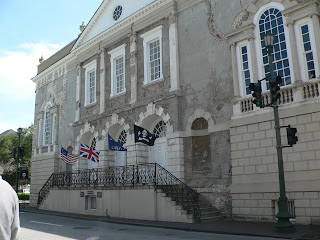Waterfront Park:


Old Exchange and Provost Dungeon, where pirates were kept in the dungeon, and where (at another time), George Washington was entertained at a ball in which he danced with all 200 ladies present:

St. Michael's, where he attended church:

The Citadel:

Magnolia Cemetery, where the last soldiers of the Civil War were interred in 2004:



Sweetgrass baskets, a local craft that has direct ties to west coast Africa:

A church on James Island, complete with live oaks and Spanish moss:

Boone Hall:

Rainbow Row, downtown--used to be warehouses, then in the 1930s some ladies decided to "restore" the area--making this very scenic, and a whole lot nicer than it was originally:

Charleston is famous for its ironwork. Perhaps you have heard of its famous ironworker artist, Philip Simmons? I don't know who did these gates--but they are very typical of the town.


Single houses were built sideways on their lots because for a time, they figured taxes based on your streetside length of your lot. To get around this, people built their houses one room wide:

Obviously, not all residents had economic concerns in mind:

And some were just nice row houses, like in Europe:

If you get the chance to visit (or live in) Charleston, you really should!
No comments:
Post a Comment